Optimizing the Delivery of GI Care in Transgender and Gender-Diverse Communities





Kira Newman, MD, PhD
Clinical Assistant Professor, Department of
Medicine, Division of Gastroenterology and
Hepatology, University of Michigan,
Ann Arbor, Michigan
Disclosures: Received research grant from: Pfizer





Overall, 1.3% of US adults identify as transgender or gender-diverse (TGD), with a higher prevalence of TGD-identified people in younger generations.1,2 This finding suggests that all clinicians will provide care to TGD patients.1,2 TGD individuals are more likely to experience health care discrimination than cisgender individuals, resulting in reduced access to and utilization of care.2,3 It is important for health care providers, including gastroenterologists and hepatologists, to create a welcoming and gender-affirming environment—offering single-occupancy handicap-accessible bathrooms, displaying nondiscrimination policies, using inclusive intake forms, and providing training for clinicians to increase knowledge of TGD health needs and address biases.3,4 This type of environment can help reduce negative outcomes for TGD patients seeking care.3,4 Understanding the minority stress model and trauma-informed care approaches can also be useful for caring for TGD patients.2,5 A recent study found that up to 51% of gastrointestinal (GI) providers are not at all familiar with trauma-informed care, highlighting the need for further education.5
High-quality research on GI conditions in TGD populations is limited, and potential proposed biological effects of gender-affirming hormone therapy (GAHT) are still theoretical. Studies have shown that the prevalence of inflammatory bowel disease (IBD) is similar between TGD and cisgender individuals, and that GAHT does not affect flare-ups of IBD, although the sample sizes have been small.6,7 Hepatic conditions such as cirrhosis were shown to be more common in TGD communities, which may be largely due to preventable causes of cirrhosis (e.g., alcohol-associated or viral etiologies) and delayed diagnosis and treatment before progression.8 More research is needed in TGD patients with GI conditions, and best practices for their design and conduct, such as partnering with TGD people, designing studies with cultural humility in mind, using rigorous research methods, and checking for implicit biases in studies, must be followed.2
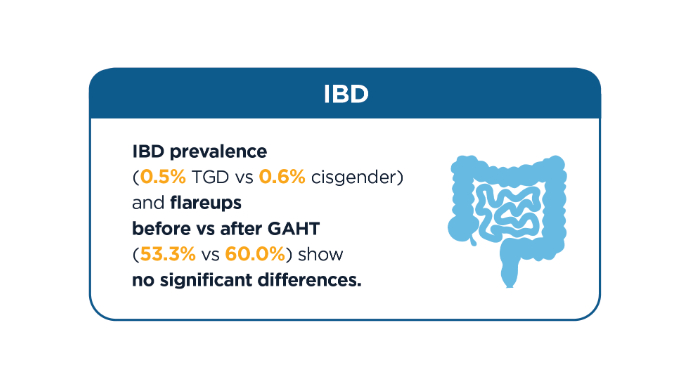 GI Conditions in TGD Patients2,6-10
GI Conditions in TGD Patients2,6-10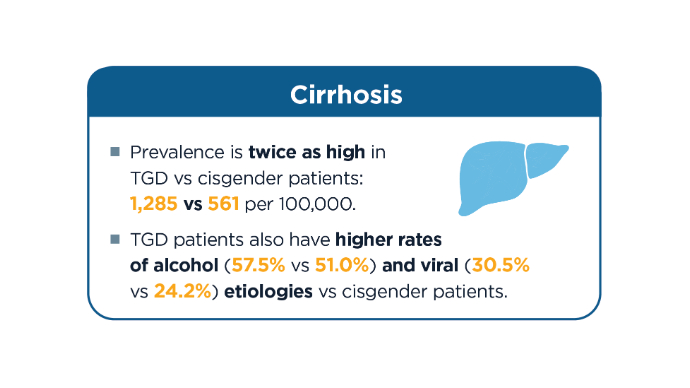 GI Conditions in TGD Patients2,6-10
GI Conditions in TGD Patients2,6-10 GI Conditions in TGD Patients2,6-10
GI Conditions in TGD Patients2,6-10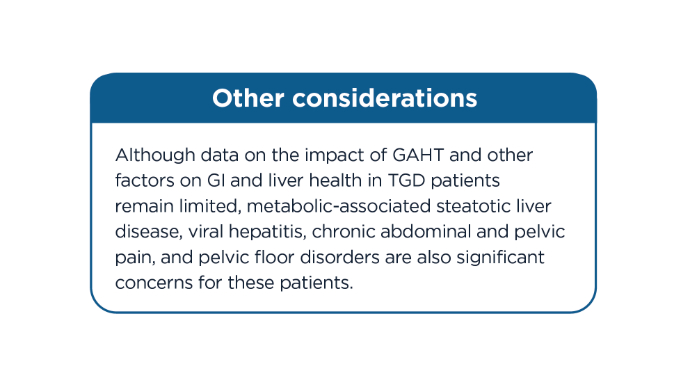 GI Conditions in TGD Patients2,6-10
GI Conditions in TGD Patients2,6-10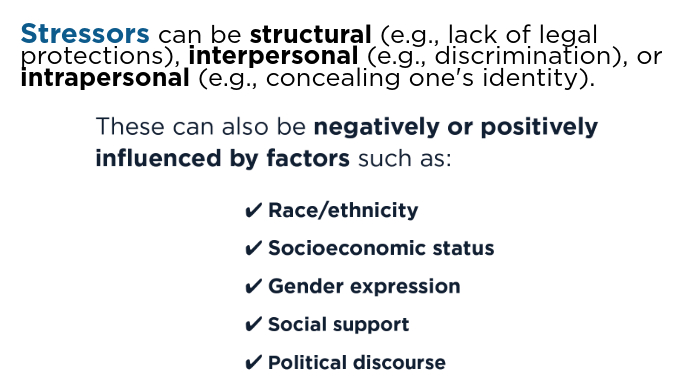 Minority Stress Model for Conceptualizing Care of TGD Patients2
Minority Stress Model for Conceptualizing Care of TGD Patients2
TGD individuals are a diverse group with varying biopsychosocial factors and GI needs. Understanding the complex experiences that TGD patients may experience can help clinicians provide more tailored, sensitive care.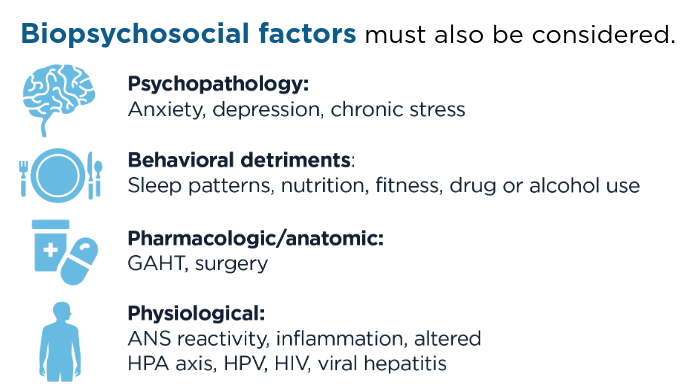 Minority Stress Model for Conceptualizing Care of TGD Patients2
Minority Stress Model for Conceptualizing Care of TGD Patients2
ANS, autonomic nervous system; HPA, hypothalamic-pituitary-adrenal axis; HPV, human papillomavirus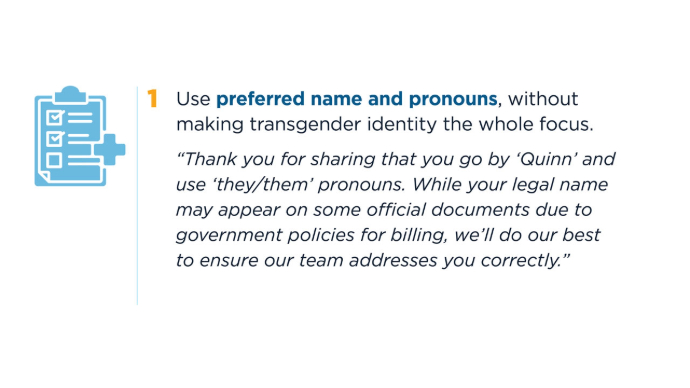 Clinical Guide for Providing GI Care to TGD Patients2,3
Clinical Guide for Providing GI Care to TGD Patients2,3 Clinical Guide for Providing GI Care to TGD Patients2,3
Clinical Guide for Providing GI Care to TGD Patients2,3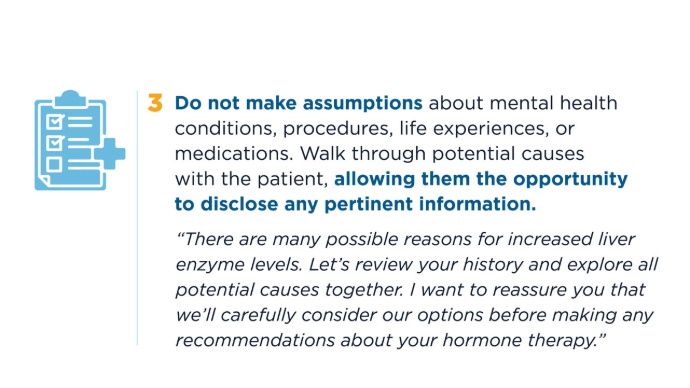 Clinical Guide for Providing GI Care to TGD Patients2,3
Clinical Guide for Providing GI Care to TGD Patients2,3 Clinical Guide for Providing GI Care to TGD Patients2,3
Clinical Guide for Providing GI Care to TGD Patients2,3 GI Conditions in TGD Patients2,6-10
GI Conditions in TGD Patients2,6-10 GI Conditions in TGD Patients2,6-10
GI Conditions in TGD Patients2,6-10 GI Conditions in TGD Patients2,6-10
GI Conditions in TGD Patients2,6-10 GI Conditions in TGD Patients2,6-10
GI Conditions in TGD Patients2,6-10 Minority Stress Model for Conceptualizing Care of TGD Patients2
Minority Stress Model for Conceptualizing Care of TGD Patients2
TGD individuals are a diverse group with varying biopsychosocial factors and GI needs. Understanding the complex experiences that TGD patients may experience can help clinicians provide more tailored, sensitive care. Minority Stress Model for Conceptualizing Care of TGD Patients2
Minority Stress Model for Conceptualizing Care of TGD Patients2
ANS, autonomic nervous system; HPA, hypothalamic-pituitary-adrenal axis; HPV, human papillomavirus Clinical Guide for Providing GI Care to TGD Patients2,3
Clinical Guide for Providing GI Care to TGD Patients2,3 Clinical Guide for Providing GI Care to TGD Patients2,3
Clinical Guide for Providing GI Care to TGD Patients2,3 Clinical Guide for Providing GI Care to TGD Patients2,3
Clinical Guide for Providing GI Care to TGD Patients2,3 Clinical Guide for Providing GI Care to TGD Patients2,3
Clinical Guide for Providing GI Care to TGD Patients2,3 GI Conditions in TGD Patients2,6-10
GI Conditions in TGD Patients2,6-10 GI Conditions in TGD Patients2,6-10
GI Conditions in TGD Patients2,6-10 GI Conditions in TGD Patients2,6-10
GI Conditions in TGD Patients2,6-10 GI Conditions in TGD Patients2,6-10
GI Conditions in TGD Patients2,6-10 Minority Stress Model for Conceptualizing Care of TGD Patients2
Minority Stress Model for Conceptualizing Care of TGD Patients2
TGD individuals are a diverse group with varying biopsychosocial factors and GI needs. Understanding the complex experiences that TGD patients may experience can help clinicians provide more tailored, sensitive care. Minority Stress Model for Conceptualizing Care of TGD Patients2
Minority Stress Model for Conceptualizing Care of TGD Patients2
ANS, autonomic nervous system; HPA, hypothalamic-pituitary-adrenal axis; HPV, human papillomavirus Clinical Guide for Providing GI Care to TGD Patients2,3
Clinical Guide for Providing GI Care to TGD Patients2,3 Clinical Guide for Providing GI Care to TGD Patients2,3
Clinical Guide for Providing GI Care to TGD Patients2,3 Clinical Guide for Providing GI Care to TGD Patients2,3
Clinical Guide for Providing GI Care to TGD Patients2,3 Clinical Guide for Providing GI Care to TGD Patients2,3
Clinical Guide for Providing GI Care to TGD Patients2,3
Click to view more from Gastroenterology Data Trends.
,false
